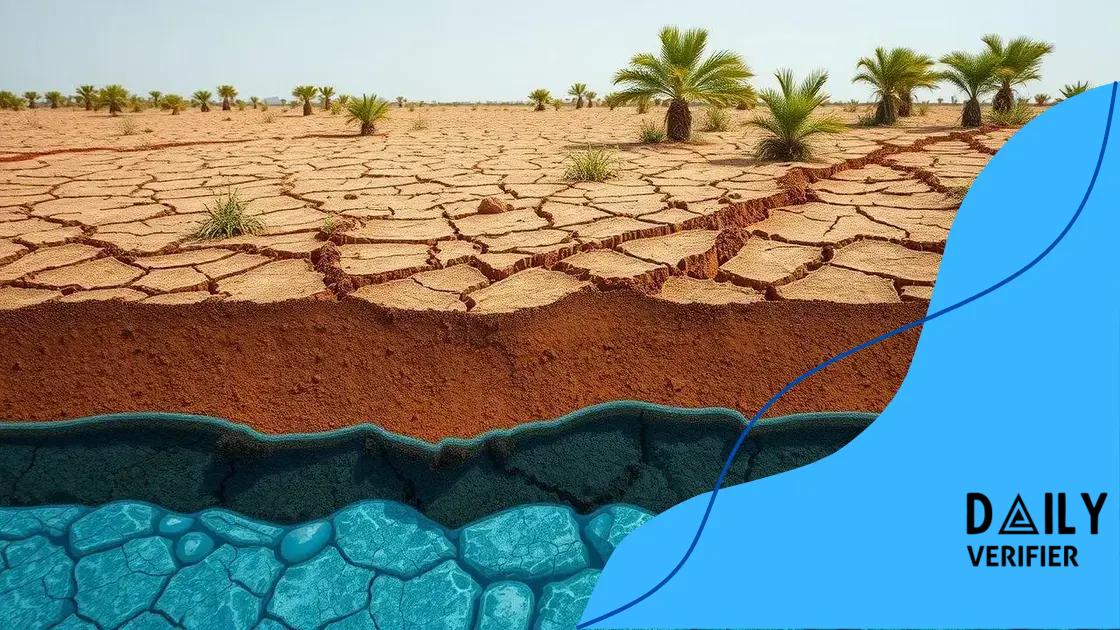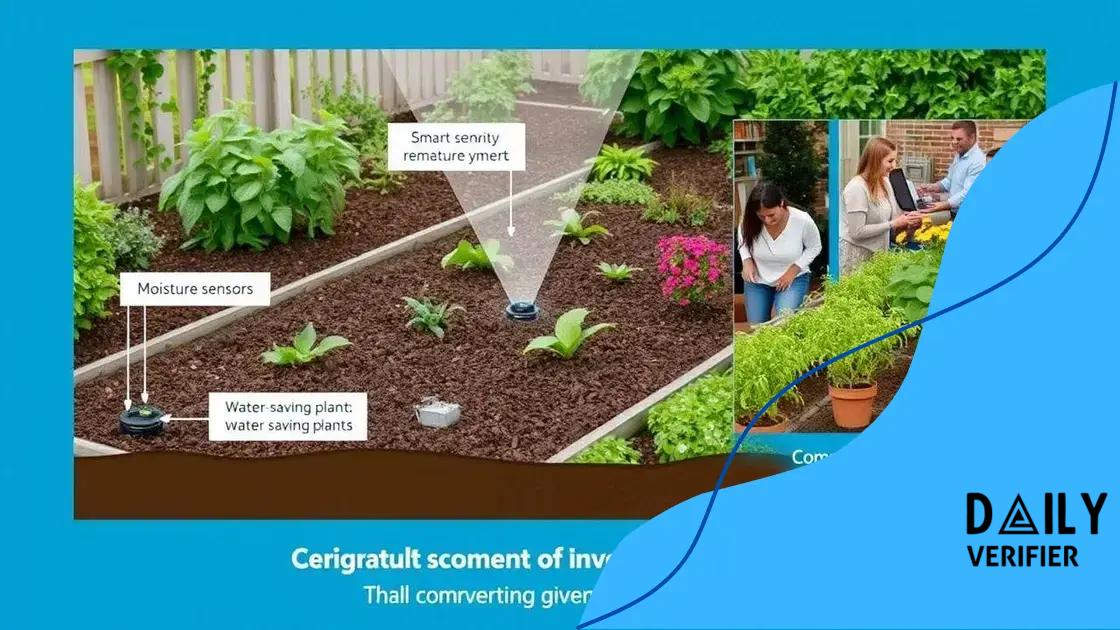Water crisis plans gain urgency as droughts escalate

Innovative water conservation strategies include community involvement, technology utilization, and education, significantly impacting water scarcity management and ensuring sustainable access to clean water for future generations.
Water crisis plans gain urgency as the world faces increasingly severe drought conditions. Have you considered how this impacts your community? Let’s dive into the pressing need for effective strategies and solutions.
Understanding the global water crisis
Water is essential for life, yet many parts of the world are experiencing a struggle with its scarcity. The global water crisis affects millions of people, making it crucial for everyone to understand its implications. This crisis is not just about a lack of water; it involves complex social, economic, and environmental factors.
What is the global water crisis?
The global water crisis refers to the significant challenges related to the availability and quality of freshwater resources. As populations grow and climate change intensifies, the pressure on water supplies increases. Urgent action is needed to avert further complications.
Key factors contributing to the crisis
Several elements influence the water crisis, making it necessary to address them urgently:
- Population growth and urbanization increase demand.
- Pollution degrades water quality.
- Climate change leads to unpredictable weather patterns.
- Mismanagement of water resources complicates effective distribution.
As these factors converge, regions across the globe face challenging realities. For instance, drought-prone areas become less able to handle water shortages, leading to conflicts and further complications.
Impacts of the water crisis
The ramifications of the water crisis extend beyond mere water shortages. Communities suffer from food insecurity due to agricultural challenges. Waterborne diseases flourish in areas with poor water quality, affecting health and productivity. Access to clean water is a basic human right that many are denied, fostering inequality.
Understanding the global water crisis is the first step towards finding a solution. Each of us can contribute by adopting conservation practices, advocating for sustainable policies, and educating others about the importance of water. The future will depend on our collective willingness to address these pressing challenges.
Key factors driving the urgency of water plans
Understanding the urgency of water plans is crucial in today’s changing climate. Various factors are driving this urgency, highlighting the need for immediate action to manage our water resources effectively.
Rapid population growth
One key factor is rapid population growth. As cities expand and more people require water, the demand increases significantly. This growing demand often outpaces the available supply, leading to shortages.
Climate change effects
Another major influence is climate change. Extreme weather patterns, including frequent droughts and heavy rainfall, disrupt the water cycle. As rainfall becomes less predictable, the management of water resources becomes ever more vital.
- Increased droughts reduce available freshwater.
- Flooding can contaminate water supplies.
- Changing temperatures affect water availability.
- Altered ecosystems impact local water sources.
The water crisis isn’t only about availability; it’s also about quality. Pollution of rivers, lakes, and groundwater can make water unsafe to drink, which compounds the issue. Poor water quality leads to health risks, underscoring the need for urgent planning.
Furthermore, mismanagement of existing water resources exacerbates the problem. Many regions lack infrastructure to store or distribute water efficiently. Innovative water plans could address these issues by ensuring that water is conserved, stored, and utilized effectively.
Overall, combining these factors highlights the critical necessity of proactive water planning. The future of communities relies on addressing these challenges head-on, utilizing sustainable practices to safeguard our precious water supplies.
Innovative strategies for drought management

As climate change leads to more frequent droughts, developing innovative strategies for drought management becomes essential. Effective solutions can help communities cope with water shortages and ensure sustainable use of this precious resource.
Water conservation techniques
One of the most effective strategies is implementing water conservation techniques. By using water-saving tools and practices, individuals and communities can significantly reduce their water usage. This includes:
- Installing low-flow fixtures in homes and businesses.
- Utilizing rainwater harvesting systems to capture and store rainfall.
- Planting drought-resistant landscaping that requires less water.
- Encouraging responsible irrigation practices in agriculture.
These conservation efforts not only conserve water but can also save money on water bills and maintenance costs.
Smart technology
Another innovative approach involves the use of smart technology. Implementing smart irrigation systems can help monitor soil moisture levels and only water plants when necessary. This technology can lead to efficient water use while maintaining healthy landscapes.
Moreover, advancements in weather forecasting and climate modeling provide farmers with valuable insights. Farmers can better time their planting and watering to align with climatic trends, reducing waste.
Engaging communities in drought management is also crucial. Public education campaigns can raise awareness about water conservation, encouraging everyone to play their part in reducing usage. Workshops and local events can foster a sense of responsibility and community in managing water resources.
Ultimately, combining these innovative strategies creates a comprehensive approach to managing drought conditions. By focusing on conservation, technology, and community engagement, we can build resilience against the impacts of water shortages.
Role of technology in addressing water scarcity
The role of technology in addressing water scarcity is becoming increasingly important as we face global challenges related to freshwater availability. Innovative technologies can help us manage water resources more efficiently and effectively, ensuring that communities have access to the water they need.
Smart water management systems
One key development is the implementation of smart water management systems. These systems use sensors and data analytics to monitor water usage in real-time. By doing so, they help identify leaks and inefficiencies in water distribution, which can save significant amounts of water.
Desalination technology
Another promising technology is desalination. This process converts salt water into freshwater, making it a viable option for coastal cities facing water shortages. As desalination technology advances, it becomes more cost-effective and energy-efficient, offering a reliable source of drinking water.
- Recent innovations utilize renewable energy for desalination.
- Modern systems can reduce environmental impact.
- Efficient filtration methods improve water quality.
Furthermore, precision agriculture is revolutionizing how we use water in farming. By employing technology like drones and soil moisture sensors, farmers can apply water more precisely where and when it is needed. This not only conserves water but also enhances crop yields.
Lastly, educational technology platforms are essential in raising awareness about water conservation. Apps and online resources can motivate individuals and businesses to adopt water-saving habits. Sharing knowledge empowers everyone to contribute to reducing water scarcity.
By harnessing these technologies, we can tackle the pressing issue of water scarcity. Leveraging innovation leads to sustainable solutions that ensure water availability for future generations.
Community involvement in water conservation efforts
Community involvement in water conservation efforts is essential for creating sustainable practices that benefit everyone. When individuals come together, they can make a significant impact on how water is used and managed.
Building awareness and education
One of the first steps is to build awareness about water conservation. Educational programs in schools, community centers, and online platforms can teach people about the importance of saving water. Simple actions, such as turning off the tap while brushing teeth, can lead to substantial savings when done collectively.
Organizing local initiatives
Communities can also organize local initiatives to promote conservation efforts. Examples include:
- Community clean-up events to keep water sources clean.
- Workshops on rainwater harvesting techniques.
- Group challenges to reduce household water use.
- Tree planting events that support healthy ecosystems.
These activities not only improve water quality but also foster a sense of community and responsibility among residents. When people work together, they build stronger bonds and encourage one another to adopt better practices.
Moreover, local governments can play a role in enhancing community involvement by supporting initiatives with resources and funding. Partnerships between local organizations, schools, and businesses can multiply efforts and result in more substantial outcomes.
Engaging social media can amplify conservation messages, connecting local efforts to broader movements. Sharing success stories and tips online inspires others to participate and adopt water-saving habits.
Community involvement changes mindsets, making water conservation a shared goal. With the right support and interest, entire neighborhoods can become champions for sustainable water practices.
In conclusion, addressing water scarcity requires collective effort and innovative strategies. By understanding the key factors behind this crisis and leveraging technology, communities can take meaningful action. Engaging local populations in conservation efforts empowers individuals and fosters a sense of responsibility. Together, we can make a difference and ensure access to clean water for future generations. Every small action counts, and with commitment and collaboration, we can tackle the challenges of the water crisis head-on.
FAQ – Questions about Water Conservation and Community Involvement
Why is community involvement important in water conservation efforts?
Community involvement creates a sense of responsibility and unity, leading to more effective conservation practices and a greater impact on water preservation.
What are some simple ways individuals can conserve water?
Simple actions include turning off the tap while brushing teeth, using a broom instead of a hose to clean driveways, and fixing leaks promptly.
How can technology aid in water conservation?
Technology provides smart management systems, precision agriculture tools, and educational resources that help communities monitor and reduce water usage efficiently.
What role do schools play in promoting water conservation?
Schools can educate students about the importance of water conservation, engage them in practical initiatives, and foster a culture of sustainability among future generations.






